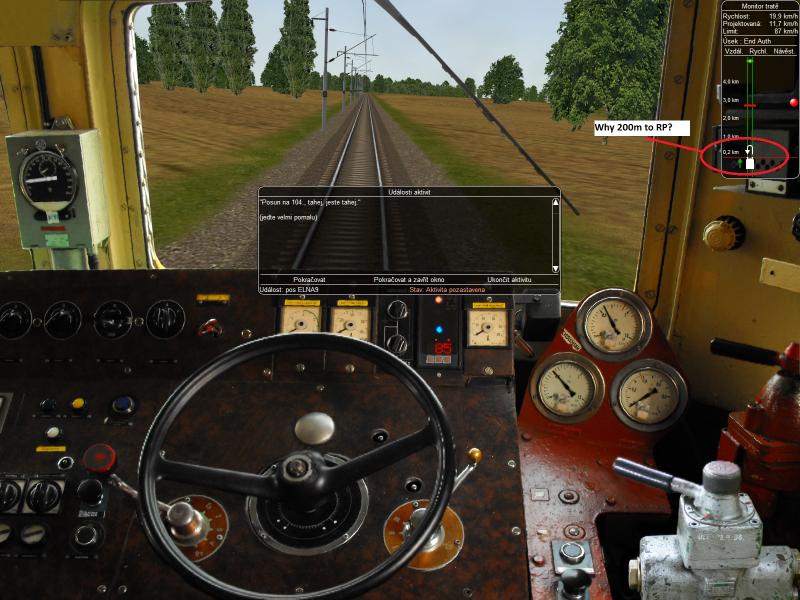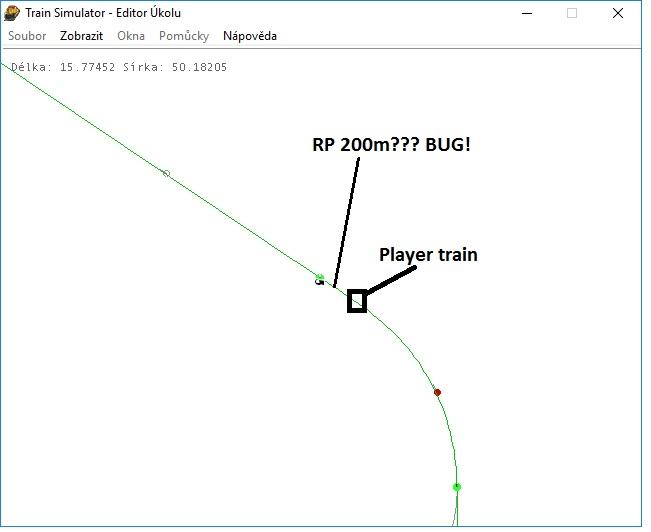Hello OR-engeneers,
I found a bug in distance to reverse point. How is it possible? Please fix it.
Page 1 of 1
Distance to reverse point - BUG!
#2

Posted 01 May 2016 - 06:45 AM
Where is the rear of your train? Probably still before the signal. OR moves the RP forward to a position where the whole train fits between RP and signal.
#3

Posted 02 May 2016 - 07:33 AM
Yes, rear of train is still before the signal. But what is drawback these feature? In the situation on the picture I need stop with rear of train behind switch and then change direction and go back. In this case the signal is not for me relevant.
#4

Posted 03 May 2016 - 01:11 AM
Csantucci, on 01 May 2016 - 06:45 AM, said:
Where is the rear of your train? Probably still before the signal. OR moves the RP forward to a position where the whole train fits between RP and signal.
I do not think that OR is behaving correctly in moving the RP. In MSTS it is a fixed spot and should be so in OR.
#5

Posted 03 May 2016 - 02:57 AM
copperpen, on 03 May 2016 - 01:11 AM, said:
I do not think that OR is behaving correctly in moving the RP. In MSTS it is a fixed spot and should be so in OR.
There are plenty of reasons not to copy reversal point behaviour from MSTS in OR :
- MSTS often moves the reversal point to the end of the 'track section', which means it is always near the next switch or signal, and therefor often near to the end of the 'track authority'.
- In MSTS, you always have to move all the way up to the reversal point even if the train is already well clear of the 'diverging' point.
- In MSTS, if there are other switches between the 'diverging' point and the reversal point, the train must clear all these intermediate switches otherwise the reversal point will not be triggered.
This means if you want to reverse a long train and there is plenty of room beyond the 'diverging' point and the reversal point, but there are other switches such that the last section upto the reversal point is much shorter, you will no be able to reverse that long train.
When setting up the processing for reversal points in OR, it was decided not to implement these serious restrictions but to make operation of reversal points much more easy and more realistic.
Two basic rules were applied :
- In signalled areas, if there is a signal between the 'diverging' point and the end of authority (usually next facing signal or switch), and the train will fit in between the signal and the end of authority, the reversal point is placed in such position that the rear of the train must have cleared the signal.
- If there are no signals, or if the train will not fit between the signal and the end of authority, the reversal point is placed in such a position that the rear of the train must have cleared the 'diverging' point.
Later, some changes were made to behaviour in activity mode such that, if the latter rule applied, the reversal point position would not be moved closer to the 'diverging' point. The first rule, however, does still apply.
The situation above is clearly one that comes under the first rule. As ever, what has been implemented is a compromise - in this case, the rule is applied as it would be in most systems where there is full signal control. Obviously there may be exceptions, but without a much more extensive definition of reversal points in which all such options could be detailed, a choice has to be made.
So, in all, this is not a bug but very much the intended behaviour.
Regards,
Rob Roeterdink
#6

Posted 03 May 2016 - 03:51 AM
roeter, on 03 May 2016 - 02:57 AM, said:
There are plenty of reasons not to copy reversal point behaviour from MSTS in OR :
When setting up the processing for reversal points in OR, it was decided not to implement these serious restrictions but to make operation of reversal points much more easy and more realistic.
Two basic rules were applied :
Rob Roeterdink
- MSTS often moves the reversal point to the end of the 'track section', which means it is always near the next switch or signal, and therefor often near to the end of the 'track authority'.
- In MSTS, you always have to move all the way up to the reversal point even if the train is already well clear of the 'diverging' point.
- In MSTS, if there are other switches between the 'diverging' point and the reversal point, the train must clear all these intermediate switches otherwise the reversal point will not be triggered.
This means if you want to reverse a long train and there is plenty of room beyond the 'diverging' point and the reversal point, but there are other switches such that the last section upto the reversal point is much shorter, you will no be able to reverse that long train.
When setting up the processing for reversal points in OR, it was decided not to implement these serious restrictions but to make operation of reversal points much more easy and more realistic.
Two basic rules were applied :
- In signalled areas, if there is a signal between the 'diverging' point and the end of authority (usually next facing signal or switch), and the train will fit in between the signal and the end of authority, the reversal point is placed in such position that the rear of the train must have cleared the signal.
- If there are no signals, or if the train will not fit between the signal and the end of authority, the reversal point is placed in such a position that the rear of the train must have cleared the 'diverging' point.
Rob Roeterdink
Personally, I've found the OR handling of reversal points has made it much easier to manoeuvre the trains. In MSTS, I often had problems with reverse points that were so critical you had to stop the train on them to the millimetre otherwise you'd run off path or SPAD.
Dennis
#7

Posted 03 May 2016 - 03:51 AM
Thank you Rob,
I was just starting preparing a long post with the same content, and you anticipated me :)
And by the way, if there is not backwards clearance, in particular for a switch, there is no other way than moving the RP forwards. Also MSTS does that for switches, but, at least before MSTSbin, it does not that well (so-called "walking reverse point"), so that you never reached the RP.
Returning to the initial issue of Icik, if he wants not to consider the signal for reversing, he could try putting the RP between switch and signal. I am not sure if this works however.
I was just starting preparing a long post with the same content, and you anticipated me :)
And by the way, if there is not backwards clearance, in particular for a switch, there is no other way than moving the RP forwards. Also MSTS does that for switches, but, at least before MSTSbin, it does not that well (so-called "walking reverse point"), so that you never reached the RP.
Returning to the initial issue of Icik, if he wants not to consider the signal for reversing, he could try putting the RP between switch and signal. I am not sure if this works however.
Page 1 of 1

 Log In
Log In Register Now!
Register Now! Help
Help






